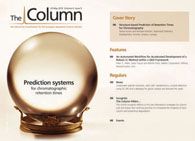Ultra-sensitive cocaine detection
The development of an ultra-sensitive gas chromatographic technique has enabled a team of researchers from the University of Derby, UK, to detect cocaine at picogram levels from forensic swabs.

The development of an ultra-sensitive gas chromatographic technique has enabled a team of researchers from the University of Derby, UK, to detect cocaine at picogram levels from forensic swabs. The method, using GC–MS, was developed by forensic science student Sonica Devi to help identify minute traces of cocaine at six phone boxes from around the city of Derby.Samples were taken using a variety of swabs, some wetted with ethanol; wetted with water; and dry swabs to maximize how much cocaine could be lifted from the surfaces of the phone box. The gas chromatograph was able to separate the cocaine from other materials, allowing detection by the mass spectrometer of levels of cocaine as low as fifty picograms.
“By improving the sensitivity of our GC–MS technique we can now see cocaine and other closely related materials down to incredibly low levels, which would not have been possible previously,” said Dr Alan-Shaun Wilkinson, senior lecturer, University of Derby, who supervised Sonica during this project. “This important piece of work opens the door to analysing a whole range of different drug types with similar sensitivities.”
This story originally appeared in The Column. Click here to view that issue.
Best of the Week: Food Analysis, Chemical Migration in Plastic Bottles, STEM Researcher of the Year
December 20th 2024Top articles published this week include the launch of our “From Lab to Table” content series, a Q&A interview about using liquid chromatography–high-resolution mass spectrometry (LC–HRMS) to assess chemical hazards in plastic bottles, and a piece recognizing Brett Paull for being named Tasmanian STEM Researcher of the Year.
Using LC-MS/MS to Measure Testosterone in Dried Blood Spots
December 19th 2024Testosterone measurements are typically performed using serum or plasma, but this presents several logistical challenges, especially for sample collection, storage, and transport. In a recently published article, Yehudah Gruenstein of the University of Miami explored key insights gained from dried blood spot assay validation for testosterone measurement.
Determination of Pharmaceuticals by Capillary HPLC-MS/MS (Dec 2024)
December 19th 2024This application note demonstrates the use of a compact portable capillary liquid chromatograph, the Axcend Focus LC, coupled to an Agilent Ultivo triple quadrupole mass spectrometer for quantitative analysis of pharmaceutical drugs in model aqueous samples.
